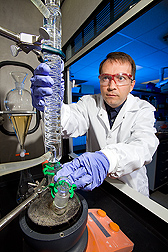This page has been archived and is being provided for reference purposes only. The page is no longer being updated, and therefore, links on the page may be invalid.
| Read the magazine story to find out more. |
|
|
 Pennycress. |
|
|
Pennycress Could Go from Nuisance Weed to New Source of Biofuel
By Ann PerryNovember 4, 2010
A common roadside plant could have the right stuff to become a new source of biofuel, according to U.S. Department of Agriculture (USDA) studies. Scientists with the Agricultural Research Service (ARS), USDA's principal intramural scientific research agency, have found that field pennycress yields impressive quantities of seeds whose oil could be used in biodiesel production.
Field pennycress belongs to the Brassicaceae family, along with canola, camelina and mustard-other prolific producers of oil-rich seeds. The ARS studies help support USDA's efforts to develop new sources of bioenergy.
At the ARS National Center for Agricultural Utilization Research in Peoria, Ill., chemists Bryan Moser, Gerhard Knothe and Terry Isbell and plant physiologist Steven Vaughn formed a team to study field pennycress' potential.
The scientists obtained oil from wild field pennycress, pretreated it with acid, and used a type of alcohol called methanol to react with the field pennycress oil to produce both biodiesel and glycerol. After some additional refining, the finished biodiesel was tested to see if it met the biodiesel fuel standard established by the American Society for Testing and Materials. The results suggested that, with some work, the previously problematic pennycress could become a commercial commodity.
All diesel-based oils start to gel when it's cold enough. So the cloud point, which is the temperature at which crystals become visible in the fuel, is a crucial factor in both biodiesel and petrodiesel production. Another important property is the pour point, the temperature at which the fuel fails to pour as a result of excessive solidification.
The average cloud and pour points for field pennycress biodiesel were 14 degrees Fahrenheit (minus 10 degrees Celsius) and minus 0.4 degrees Fahrenheit (minus 18 degrees Celsius), respectively. These temperatures were well below the cloud and pour points of soybean oil-based biodiesel. This result suggests that field pennycress biodiesel is better suited for use in cold climates than many other biodiesel fuels, such as soybean oil-based biodiesel.
Another plus: Pennycress can be grown during the winter and harvested in late spring, so farmers who cultivate pennycress can also maintain their usual summer soybean production without reducing crop yields.
Results from this work were published in Energy & Fuels.
Read more about ARS studies on pennycress in the November/December 2010 issue of Agricultural Research magazine.

